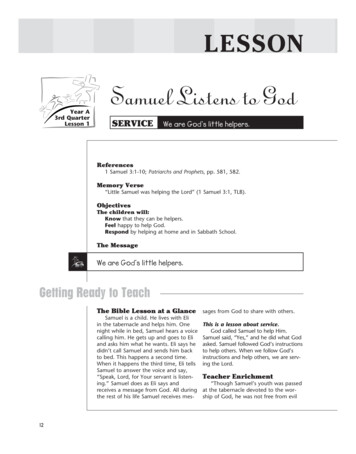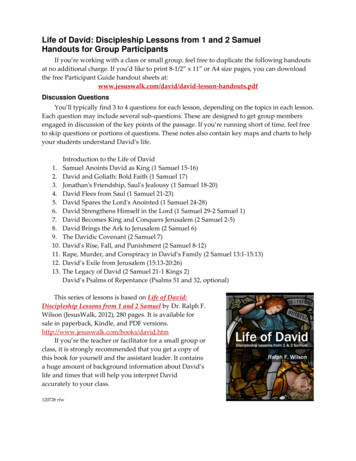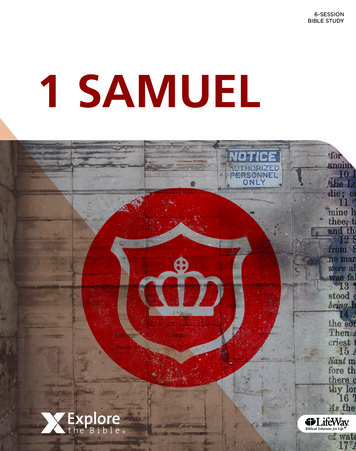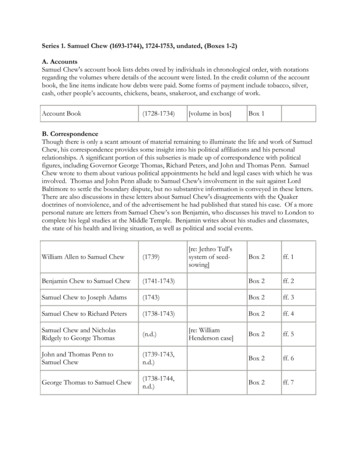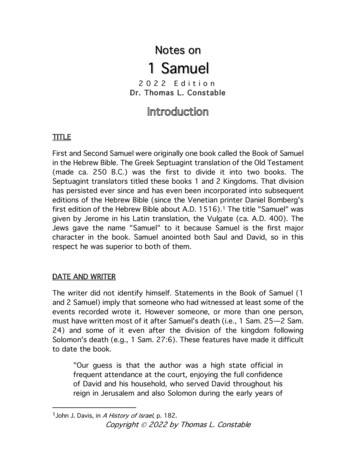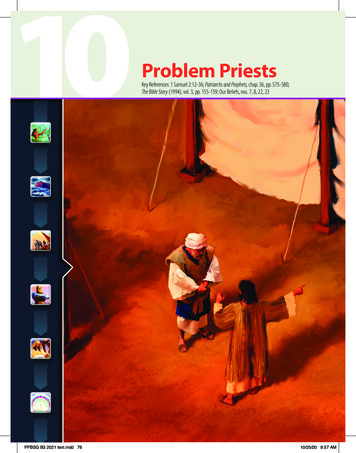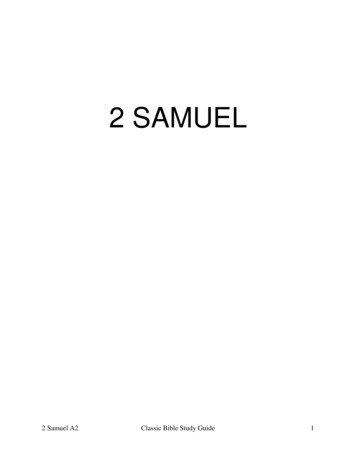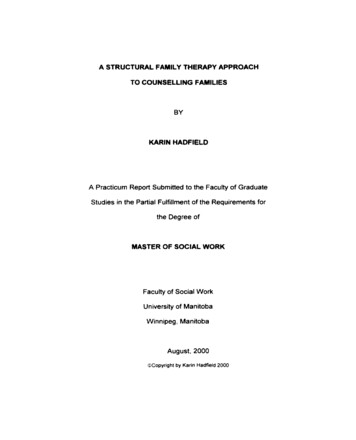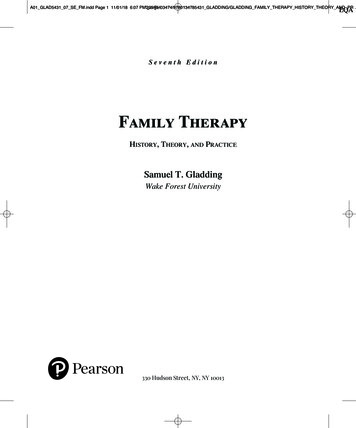
Transcription
.A01 GLAD5431 07 SE FM.indd Page 1 11/01/18 6:07 PM/205/PH03474/9780134785431 GLADDING/GLADDING FAMILY THERAPY HISTORY THEORY AND PRgangaSeventh EditionFamily TherapyHistory, Theory, and PracticeSamuel T. GladdingWake Forest University330 Hudson Street, NY, NY 10013
.A01 GLAD5431 07 SE FM.indd Page 2 12/01/18 3:49 PM/205/PH03474/9780134785431 GLADDING/GLADDING FAMILY THERAPY HISTORY THEORY AND PRgangaDirector and Publisher: Kevin M. DavisPortfolio Manager: Rebecca Fox-GiegContent Producer: Pamela D. BennettMedia Producer: Lauren CarlsonPortfolio Management Assistant: Casey CoriellExecutive Field Marketing Manager: Krista ClarkExecutive Product Marketing Manager: Christopher BarryProcurement Specialist: Deidra SmithCover Designer: Melissa Welch, Studio MontageCover Photo: Theo Allofs/Corbis/Getty ImagesFull-Service Project Management: Sudip Sinha,iEnergizer Aptara , Ltd.Composition: iEnergizer Aptara , Ltd.Printer/Binder: LCS CrawfordsvilleCover Printer: Phoenix Color/HagarstownText Font: Times LT Pro 10/12Copyright 2019, 2015, 2011 by Pearson Education, Inc. or its affiliates. All Rights Reserved. Printed in the United States ofAmerica. This publication is protected by copyright, and permission should be obtained from the publisher prior to any prohibitedreproduction, storage in a retrieval system, or transmission in any form or by any means, electronic, mechanical, photocopying,recording, or otherwise. To obtain permission(s) to use material from this work, please visit ts of third party content appear on the page within the text, which constitute an extension of this copyright page.Unless otherwise indicated herein, any third-party trademarks that may appear in this work are the property of their respective ownersand any references to third-party trademarks, logos or other trade dress are for demonstrative or descriptive purposes only. Suchreferences are not intended to imply any sponsorship, endorsement, authorization, or promotion of Pearson’s products by the ownersof such marks, or any relationship between the owner and Pearson Education, Inc. or its affiliates, authors, licensees or distributors.Library of Congress Cataloging-in-Publication DataNames: Gladding, Samuel T., author.Title: Family therapy : history, theory, and practice / Samuel T. Gladding, Wake Forest University.Description: Seventh edition. Boston : Pearson, [2019] Revised edition of: Family therapy : history, theory, and practice /Samuel T. Gladding. Sixth edition. [2015]. Includes bibliographical references and indexes.Identifiers: LCCN 2017042455 ISBN 9780134785431 ISBN 0134785436Subjects: LCSH: Family psychotherapy.Classification: LCC RC488.5 .G535 2019 DDC 616.89/156—dc23 LC record available at https://lccn.loc.gov/2017042455118ISBN 10: 0-13-478543-6ISBN 13: 978-0-13-478543-1
.A01 GLAD5431 07 SE FM.indd Page 3 11/01/18 6:07 PM/205/PH03474/9780134785431 GLADDING/GLADDING FAMILY THERAPY HISTORY THEORY AND PRgangaPREFACEPHILOSOPHYTherapeutic work with families is a recent scientific phenomenon but an ancient art. Throughouthuman history, designated persons in all cultures have helped couples and families cope, adjust,and grow. In the United States, the interest in assisting families within a healing context began inthe 20th century and continues into the 21st. Family life has always been of interest, but becauseof economic, social, political, and spiritual values, outsiders made little direct intervention,except for social work, into ways of helping family functioning until the 1950s. Now, there areliterally thousands of professionals who focus their attention and skills on improving familydynamics and relationships.In examining how professionals work to assist families, the reader should keep in mindthat there are as many ways of offering help as there are kinds of families. However, the mostwidely recognized methods are counseling, therapy, educational enrichment, and prevention.The general umbrella term for remediation work with families is family therapy. This conceptincludes the type of work done by family professionals who identify themselves by differenttitles, including marriage and family therapists, licensed professional counselors, psychologists,psychiatrists, social workers, psychiatric nurses, pastoral counselors, and clergy.Family therapy is not a perfect term; it is bandied about by a number of professional associations, such as the American Association for Marriage and Family Therapy (AAMFT), theAmerican Counseling Association (ACA), the American Psychological Association (APA), theAmerican Medical Association (AMA), and the National Association of Social Workers(NASW). Physicians who treat families also debate this term. As doctors, are they “family therapists,” or, because they are engaged in the practice of medicine, are they “family medical specialists”? For purposes of this book, the generic term family therapy is used because of its wideacceptance among the public and professionals who engage in the practice of helping families.Within this term, some aspects of educational enrichment and prevention are included.ORGANIZATIONAs a comprehensive text, this book focuses on multiple aspects of family therapy.Part 1 introduces the reader to the foundations on which family therapy is built, such asgeneral systems theory, cybernetics, and the history of the profession. It also acquaints readerswith various types of families and family forms (e.g., nuclear, single parent, blended), characteristics of healthy and dysfunctional families, and cultural as well as ethical and legal considerationsin working with families.Part 2 examines the main theoretical approaches to working therapeutically with couples andfamilies. For couples, these theories are behavioral couple therapy (BCT), cognitive–behavioralcouple therapy (CBCT), and emotionally focused therapy (EFT). For families, major theories arepsychodynamic, Bowen (or transgenerational), experiential (including feminist), behavioral,cognitive–behavioral, structural, strategic, solution-focused, and narrative approaches. Eachtheoretical chapter emphasizes the major theorist(s) of the approach, premises, techniques,process, outcome, and unique aspects of the theory, and a comparison with other approaches. Caseillustrations and brief cases applying the theory are also provided.iii
.A01 GLAD5431 07 SE FM.indd Page 4 11/01/18 6:07 PM/205/PH03474/9780134785431 GLADDING/GLADDING FAMILY THERAPY HISTORY THEORY AND PRgangaivPrefacePart 3 covers professional issues and research in family therapy, with a chapter specificallyabout working with substance-related disorders, domestic violence, and child abuse and anotherchapter on research and assessment in family therapy. This part of the book is the briefest, but itis also meaty in focusing on issues that are relevant to society and to the health and well-being ofpeople and the profession.As you read, consider Miller’s (1990) four-level pyramid of clinical competence. In thisconceptualization, the base of the pyramid is built on factual knowledge gained by reading andstudying didactic information. One level up is “knows how,” or the ability to apply the knowledge gained on the previous level. On top of that level is “shows how,” which is represented bythe person’s ability to act appropriately in a practical or simulated situation. At the top of thepyramid is the “does” level, which is actual clinical work in regular practice (Miller, 2010). Thepresent text can be considered as the base of the pyramid, with exercises to help you begin toreach the second and third levels, so that with advanced training you will be able to functioneffectively at the final level.DoesShows howKnows howKnowsNEW TO THIS EDITIONThe seventh edition of Family Therapy is considerably different from the sixth edition. Highlights of the differences are as follows: First, the organization of the book is different. There are now 18 instead of 16 chapters.Each of the eight major theories in family therapy now have their own chapter, whichmakes focusing on the theories more specific. Second, the book has much fresh material. For instance, there are over 240 new sourcescited altogether. Third, 31 new charts have been added to the chapters in the text. These charts summarizesome of the major points in the chapters, such as clinical techniques, and thus help thereader remember important information better. Fourth, the glossary of family therapy terms has been updated and refreshed. Fifth, new material within chapters have been added on working with singles, stress, intercultural families, ethics, new couple adjustment, emotionally-focused therapy, defensemechanisms, functional family and behavioral family therapy, structural family therapy,and qualitative research. Sixth, an Epilogue has been added to the back of the book. Seventh, 25 new cases have been added to the eight family theories chapters. These casesare brief and, with only a slight play on words intended, they are titled “Brief Cases.”
.A01 GLAD5431 07 SE FM.indd Page 5 11/01/18 6:07 PM/205/PH03474/9780134785431 GLADDING/GLADDING FAMILY THERAPY HISTORY THEORY AND PRgangaPrefaceOverall, the seventh edition of Family Therapy is a much different text than its predecessors. It is more developmental and current, better illustrated with examples and charts, and amore thoroughly researched and reflective book, without sacrificing content or readability. Thereis an emphasis on both the reader’s family of origin and families he or she will work with. Theseventh edition of Family Therapy takes a broader and more progressive approach to treatingfamilies, while remaining rich in covering theories and ways of preventing families from becoming dysfunctional.ALSO AVAILABLE WITH MYLAB COUNSELINGThis title is also available with MyLab Counseling, an online homework, tutorial, and assessment program designed to work with the text to engage students and improve results. Within itsstructured environment, students see key concepts demonstrated through video clips, practicewhat they learn, test their understanding, and receive feedback to guide their learning and ensurethey master key learning outcomes. Learning Outcomes and Standards measure student results. MyLab Counselingorganizes all assignments around essential learning outcomes and national standards forcounselors. Video- and Case-Based Exercises develop decision-making skills. Video- and Casebased Exercises introduce students to a broader range of clients, and therefore a broaderrange of presenting problems, than they will encounter in their own pre-professional clinical experiences. Students watch videos of actual client-therapist sessions or high-qualityrole-play scenarios featuring expert counselors. They are then guided in their analysis ofthe videos through a series of short-answer questions. These exercises help studentsdevelop the techniques and decision-making skills they need to be effective counselorsbefore they are in a critical situation with a real client. Licensure Quizzes help students prepare for certification. Automatically graded,multiple-choice Licensure Quizzes help students prepare for their certification examinations, master foundational course content, and improve their performance in the course. Video Library offers a wealth of observation opportunities. The Video Library provides more than 400 video clips of actual client-therapist sessions and high-quality roleplays in a database organized by topic and searchable by keyword. The Video Libraryincludes every video clip from the MyLab Counseling courses plus additional videos fromPearson’s extensive library of footage. Instructors can create additional assignmentsaround the videos or use them for in-class activities. Students can expand their observationexperiences to include other course areas and increase the amount of time they spendwatching expert counselors in action.A PERSONAL NOTEIn undertaking the writing of this work, I have been informed not only by massive amounts ofreading in the rapidly growing field of family therapy, but also by my experiences during thelast 40 years of therapeutically working with families. Both my family of origin and currentfamily of procreation have influenced me as well. In addition, as a member of both the American Association for Marriage and Family Therapy and the International Association for Marriage and Family Counselors, I have tried to view families and family therapy from the broadestv
.A01 GLAD5431 07 SE FM.indd Page 6 11/01/18 6:07 PM/205/PH03474/9780134785431 GLADDING/GLADDING FAMILY THERAPY HISTORY THEORY AND PRgangaviPrefacebase possible. Readers should find information in this work that will help them gain a clearperspective on the field of family therapy and those involved with it.Like the authors of most books, I truly hope that you as a reader enjoy and benefit fromthe contents of this text. It is my wish that when you complete your reading, you will havegained a greater knowledge of family therapy, including aspects of prevention, enrichment, andtherapy that affect you personally as well as professionally. If such is the case, then you willhave benefited and possibly changed. I, as an author, will have accomplished the task that I setout to do.ACKNOWLEDGMENTSI am grateful to the reviewers who spent many hours critiquing the first three editions of thisbook. They are: James Bitter, California State University at Fullerton; Donald Bubenzer, KentState University; Harper Gaushell, Northeast Louisiana University; J. Scott Hinkle, Universityof North Carolina at Greensboro; Gloria Lewis, Loyola University of Chicago; Donald Mattson,University of South Dakota; Eugene R. Moan, Northern Arizona University; Tom Russo, University of Wisconsin, River Falls; Charles P. Barnard, University of Wisconsin–Stout; PeterEmerson, Southeastern Louisiana University; Michael Carns, Southwest Texas State University;Thomas A. Cornille, Florida State University; Merith Cosden, University of California, SantaBarbara; Vonda Jump, Utah State University; and Jeffrey M. Smith, Kent State University.I would like to express appreciation to those who critiqued the fourth, fifth, and sixth editions of this text as well: Joseph F. Bertinetti, University of Nebraska–Omaha; Alan Demmitt,University of Dayton; Grace Mims, University of South Dakota; William H. Quinn, Universityof Georgia; David A. Spruill, Louisiana State University, Gonzalo Bacigalupe, University ofMassachusetts; Linda Horsey, Old Dominion University; William O’Connell, Xavier University; Eric Albers, University of Nevada, Reno; Kurt D. Baker, California State University, Stanislaus; Kimberly Donovan, Southeastern Oklahoma State University; Tamara Coder Mikinski,University of Kansas; and Sangeeta Singg, Angelo State University.Finally, I wish to thank the reviewers of this seventh edition: Mary Andres, University ofSouthern California; Ben Beitin, Seton Hall University; Marjorie C. Shavers, HeidelbergUniversity; and Chaim Yacov Tarshish, City College (CUNY)/Touro College.I especially want to thank my graduate research assistants for the academic year2016–2017: Emma Porter and Marlena Del Hierro. They provided me with some strong literaturereviews. In addition, I am indebted to my graduate assistant in 2012–2013, Lindsay Berg, andthe summer of 2009, Ned Martin, for their tireless efforts in helping me find updated statisticsand articles for this and the previous edition of Family Therapy and for making excellent suggestions about individual chapters and the book as a whole. Ned even proofread a couple of chaptersof the book, which helped me a lot. Similarly, Cassie Cox, my graduate assistant during theacademic year 2008–2009, supplied me with valuable materials for this book, and I am mostgrateful to her. Furthermore, Trevor Buser, another graduate assistant back in 2006, helped melocate massive amounts of information for the fourth edition. He went on to earn his Ph.D. and isa professor of counseling at Rider University, which does not surprise me, because his workethic and efficiency, like that of the others I have mentioned, was exceptional. In addition,Virginia Perry of Winston-Salem, my former graduate assistants, Michele Kielty-Briggs andJenny Cole, and the current program manager of the Department of Counseling, Pamela Karr, of
.A01 GLAD5431 07 SE FM.indd Page 7 11/01/18 6:07 PM/205/PH03474/9780134785431 GLADDING/GLADDING FAMILY THERAPY HISTORY THEORY AND PRgangaPrefaceWake Forest University, have been constructive and positive in their input on previous editionsof this text as well. I am most grateful to them. Also, I am indebted to my current editor atPearson, Rebecca Fox-Gieg, for her tireless effort, support, and assistance on my behalf. She hasbeen a pleasure to work with, as were Meredith Fossel and Kevin Davis, my previous editors.This text is dedicated to my family, especially my parents. My father died in April 1994, atthe age of 84, soon after I completed the first edition of this text. My mother died in August,2000, only 2 months short of turning 90, just as I was finishing the third edition of the book. Thelove and courage of both my parents, along with the legacy left to me by previous generations ofmy family, have affected me positively. I know I am most fortunate.Finally, and as important, I am indebted to my wife, Claire, for her encouragement andcomfort during the writing process. She has insisted throughout this effort, as through our31 years of marriage, that we talk and build our relationship as a couple. She has employed all ofher communication skills, including a generous dose of humor, to help me be a better spouse.She has also been, throughout this time, my partner, friend, and lover in the raising of our threechildren: Ben, Nate, and Tim.Samuel T. Gladdingvii
.A01 GLAD5431 07 SE FM.indd Page 8 11/01/18 6:07 PM/205/PH03474/9780134785431 GLADDING/GLADDING FAMILY THERAPY HISTORY THEORY AND PRgangaABOUT THE AUTHORSamuel T. Gladding is a professor in the Department ofCounseling at Wake Forest University, Winston-Salem, NorthCarolina. He has been a practicing counselor in public andprivate agencies since the 1970s. His leadership in the field ofcounseling includes service as the following: P resident of the International Association of Marriage andFamily Counselors (IAMFC). President of the Alabama Association of Marriage and Family Therapists.Approved supervisor, American Association for Marriage and Family Therapy.President of the American Counseling Association (ACA) and chair of the ACA Foundation.President of the Association for Counselor Education and Supervision (ACES).President of the Association for Specialists in Group Work (ASGW).President of Chi Sigma Iota (international academic and professional counseling honor society).President of the American Association of State Counseling Boards (AASCB).Dr. Gladding is the former editor of the Journal for Specialists in Group Work and the ASGWnewsletter. He is also the author of more than 100 professional publications. In 1999, he was citedas being in the top 1% of contributors to the Journal of Counseling and Development for the 15-yearperiod from 1978 to 1993. Some of his most recent books include The Counseling Dictionary, 4thedition (2017); Counseling: A Comprehensive Profession, 8th edition (2018); Group Work: ACounseling Specialty, 7th edition (2016); and The Creative Arts in Counseling, 5th edition (2016).Dr. Gladding’s previous academic appointments have been at the University of Alabama atBirmingham, Fairfield University (Connecticut), and Rockingham Community College (Wentworth,North Carolina). He was also director of Children’s Services at the Rockingham County (NorthCarolina) Mental Health Center. He received his degrees from Wake Forest (B.A., M.A. Ed.), Yale(M.A.R.), and the University of North Carolina–Greensboro (Ph.D.). He is a National CertifiedCounselor, a Certified Clinical Mental Health Counselor, and a Licensed Professional Counselor(North Carolina). He was a member of the North Carolina Board of Licensed Professional Counselorsfrom 2008 to 2014 and has twice been a Fulbright Specialist: Turkey (2010) and China (2013).Dr. Gladding is the recipient of numerous honors, including the David K. BrooksDistinguished Mentor Award, American Counseling Association; the Arthur A. HitchcockDistinguished Professional Service Award, American Counseling Association; the Research inFamily Counseling Award, International Association of Marriage and Family Counselors; theGilbert and Kathleen Wrenn Award for a Humanitarian and Caring Person, American CounselingAssociation; the Bridgebuilder Award, American Counseling Association Foundation; theHumanitarian Award, Association for Spiritual, Ethical, and Religious Values in Counseling;the Lifetime Achievement Award, Association for Creativity in Counseling; the Joseph W. andLucille U. Hollis Outstanding Publication Award Association for Humanistic Counseling; theProfessional Leadership Award, Association for Counselor Education and Supervision; andthe Eminent Career Award, Association for Specialists in Group Work. He is also a Fellow inthe American Counseling Association and the Association for Specialists in Group Work.Dr. Gladding is married to the former Claire Tillson and is the father of three children—Ben, Nate, and Tim. Outside of counseling, he enjoys swimming, walking, and humor.viii
.A01 GLAD5431 07 SE FM.indd Page 9 11/01/18 6:07 PM/205/PH03474/9780134785431 GLADDING/GLADDING FAMILY THERAPY HISTORY THEORY AND PRgangaBRIEF CONTENTSPrologue xixPART 1 Foundations of Family TherapyChapter 1Chapter 2Chapter 3Chapter 4Chapter 5Chapter 61The History of Family Therapy: Evolution andRevolution 2The Theoretical Context of Family Therapy 27Types and Functionality of Families 56Working with Single-Parent and Blended Families 80Working with Culturally Diverse Families 105Ethical, Legal, and Professional Issues in Family Therapy 127PART 2 Therapeutic Approaches to Working with Families 153Chapter 7Chapter 8Chapter 9Chapter 10Chapter 11Chapter 12Chapter 13Chapter 14Chapter 15Chapter 16The Process of Family Therapy 154Couples and Marriage Therapy and EnrichmentPsychodynamic Family Theory 211Bowen Family Systems Theory 226Behavioral and Cognitive–Behavioral FamilyTherapies 243Experiential Family Therapy 266Structural Family Therapy 290Strategic Family Therapies 309Solution-Focused Brief Therapy 330Narrative Family Therapy 344181PART 3 Professional Issues and Research in FamilyTherapy 359Chapter 17 Research and Assessment in Family Therapy 360Chapter 18 Working with Substance-Related Disorders, DomesticViolence, and Child Abuse 380Epilogue 402AppendixModels of Family Therapy404ix
/205/PH03474/9780134785431 GLADDING/GLADDING FAMILY THERAPY HISTORY THEORY AND PR.A01 GLAD5431 07 SE FM.indd Page 10 11/01/18 6:07 PMgangaCONTENTSProloguexixPart 1 Foundations of Family Therapy 1Chapter 1 THE HISTORY OF FAMILY THERAPY: EVOLUTION ANDREVOLUTION 2Chapter Overview2Catalysts for the Growth of Family Therapy 3Family Therapy: 1940 to 1949 4 Family Therapy:1950 to 1959 5 Family Therapy: 1960 to 1969 7 Family Therapy: 1970 to 1979 11 Family Therapy:1980 to 1989 15 Family Therapy: 1990 to 1999 17 Family Therapy: 2000 to 2009 20 Continued Developmentof the Profession 21 Family Therapy: 2010 to thePresent 22Summary and Conclusion 23 Summary Table 24Chapter 2 THE THEORETICAL CONTEXT OF FAMILY THERAPY27Chapter Overview 27Families, Systems, and Systems Theory 28What Is a Family? 29 What Is a System, and What IsSystems Theory? 30 Systems Theory 31 Cyberneticsand Causality 31 Feedback and Feedback Loops 32Individual Development and Family Life Cycle Development 35Individual and Family Development 35 Individual LifeCycle Development 36 Family Life Development 38Unifying Individual and Family Life Cycles 48Implications of Life Cycles for Family Therapy 48Match of Life Cycles Between Family and Therapist 49 Ethnicity and Life Cycles 49 Acute and Chronic Illnessesand Life Cycles 50 Special-Needs Children and LifeCycle 51 Poverty, Professionalism, and Life Cycles 51Summary and Conclusion 53 Summary Table 53Chapter 3 TYPES AND FUNCTIONALITY OF FAMILIES56Chapter Overview 56Types of Families 57Qualities Associated with Healthy and Dysfunctional FamiliesQualities of Healthy Families 61x60
/205/PH03474/9780134785431 GLADDING/GLADDING FAMILY THERAPY HISTORY THEORY AND PR.A01 GLAD5431 07 SE FM.indd Page 11 11/01/18 6:07 PMgangaContentsFamily Life Stressors 66Expected Life Stressors 67 Unexpected Life Stressors 68Family Structure and Functionality 70Symmetrical/Complementary Families 70 Centripetal/Centrifugal Families 71 Cohesion/Adaptability 72Coping Strategies of Families 73Implications of Health in Working with Families 76Summary and Conclusion 77 Summary Table 78Chapter 4 WORKING WITH SINGLE-PARENT AND BLENDEDFAMILIES 80Chapter Overview 80Single-Parent Families 81Types of Single-Parent Families 81Single Parenthood as a Result of Divorce 81 SingleParenthood as a Result of Death 82 Single Parenthood byChoice 84 Single Parenthood as a Result of TemporaryCircumstances 84Strengths and Challenges Connected with Single-Parent Families 85Strengths of Single-Parent Families 85 Challenges ofSingle-Parent Families 86Approaches for Working with Single-Parent Families 87Prevention Approaches 87 Educational and BehavioralApproaches 87Role of the Therapist 88Process and Outcome 89Blended Families 90Forming Blended Families 91Common Concerns of Blended Families 91 Dealing withthe Death of a Parent 91 Dealing with the Divorce of aCouple 93Strengths and Challenges of Blended Families 94Strengths of Blended Families 94 Challenges of BlendedFamilies 95Approaches for Treating Blended Families 97Guidance in Retaining Old Loyalties 97 Focus on ParentalInvolvement 97 Provide Education 97 Assist in theCreation of Family Traditions and Rituals 98Role of the Therapist 99Process and Outcome 100Summary and Conclusion 101 Summary Table 102xi
/205/PH03474/9780134785431 GLADDING/GLADDING FAMILY THERAPY HISTORY THEORY AND PR.A01 GLAD5431 07 SE FM.indd Page 12 11/01/18 6:07 PMgangaxiiContentsChapter 5 WORKING WITH CULTURALLY DIVERSE FAMILIES105Chapter Overview 105What Is Culture and Why Is it Important? 106Dynamics Associated with Culturally Diverse Families 108Issues with Culturally Diverse Families 109Sensitivity 109 Experience 110 Acceptance 110Ingenuity 110 Specificity 111 Intervention 111Working with Culturally Diverse Families 112Approaches for Working with Culturally Diverse Families 112Lesbian, Gay, Bisexual, and Transgender (LGBT) Families 113 African American Families 114 Asian AmericanFamilies 115 Hispanic/Latino American Families 116 American Indians and Alaska Natives Families 118 ArabAmerican Families 119 European AmericanFamilies 120 Intercultural Families 120Guidelines for Selecting Treatment Approaches 121Role of the Therapist 121Summary and Conclusion 122 Summary Table 123Chapter 6 ETHICAL, LEGAL, AND PROFESSIONAL ISSUES INFAMILY THERAPY 127Chapter Overview 127Overview of Ethics in Families and Family Therapy 128Guidelines for Making Ethical Decisions 129Codes of Ethics 129 Educational Resources 130 Professional Consultation 130 Interaction withColleagues and Supervisors 131 MetaethicalPrinciples 131 Scaling 131Common Ethical Concerns 132Confidentiality 133 Gender Issues 134 SexBetween a Therapist and a Family Member 135 Theoretical Techniques 135 Multicultural TherapyIssues 135 Use of the Internet for Online Therapy 136Addressing Unethical Behavior 137Legal Issues in Family Therapy 138The Legal System 138Types of Law 139Legal Situations that Involve Family Therapists 140Issues of Law in Family Therapy 142Managed Care 143
/205/PH03474/9780134785431 GLADDING/GLADDING FAMILY THERAPY HISTORY THEORY AND PR.A01 GLAD5431 07 SE FM.indd Page 13 11/01/18 6:07 PMgangaContentsProfessional Identification as a Family Therapist 144Demographics: Who Are Marriage and FamilyTherapists? 144 Organizations Associated with FamilyTherapy 145 Education of FamilyTherapists 148 Issues in Professional Identification 148Summary and Conclusion 148 Summary Table 149Part 2 Therapeutic Approaches to Working with Families 153Chapter 7 THE PROCESS OF FAMILY THERAPY154Chapter Overview 154Common Factors in Therapy 155The Personhood of the Family Therapist 156Common Problems of Beginning Family Therapists 157Overemphasis 157 Underemphasis 160Appropriate Process 163Pre-Session Planning and Tasks 164 InitialSession(s) 165 Middle Phase ofTreatment 170 Termination 174An Example of Appropriate Process in Family Therapy 176Initial Session(s) 176 Middle Phase of Treatment 177Reorientation and change 177 Termination 177Summary and Conclusion 178 Summary Table 179Chapter 8 COUPLES AND MARRIAGE THERAPY ANDENRICHMENT 181Chapter Overview 181Types of Couples and Marriage Treatments 182Preventive Approaches to Working with Couples 183Major Theorists in Marriage Preparation and CoupleEnrichment: David and Vera Mace and John Gottman 184Major Theories for Prevention 186Marriage and Relationship Education 186 MarriageEnrichment 187Marriage and Couples Therapy 190Major Theorists: Susan Johnson (1947–) 190 TherapeuticApproaches for Working with Couples 191 BehavioralCouples Therapy 191 Cognitive–Behavioral CouplesTherapy 195 Emotionally Focused Therapy (EFT) 196Infidelity 201Approaches for Treating Infidelity 202 xiii
/205/PH03474/9780134785431 GLADDING/GLADDING FAMILY THERAPY HISTORY THEORY AND PR.A01 GLAD5431 07 SE FM.indd Page 14 11/01/18 6:07 PMgangaxivContentsDivorce Therapy, Mediation, and Collaboration 204Divorce Therapy 205 Family Mediation 206 Collaborative Divorce 206Summary and Conclusion
ALSO AVAILABLE WITH MYLAB COUNSELING This title is also available with MyLab Counseling, an online homework, tutorial, and assess-ment program designed to work with the text to engage students and improve results. Within its structured environment, students see key concepts de
